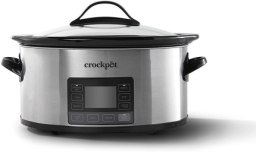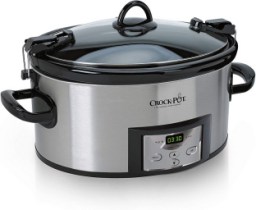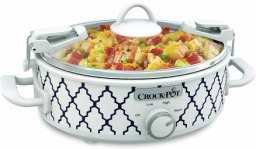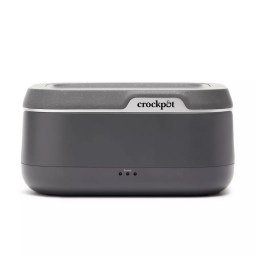Buying guide for Best crock-pots
Do you dream of arriving home after a long day at work to find dinner cooked and waiting for you? Do you like to watch your pennies at the grocery store, but still want tender, flavorful cuts of meat? Do you dread facing a sink full of pots and pans after cooking? If your answer to the above is a resounding, “Yes!” then the answer to your prayers is a Crock-Pot.
While it’s true that a Crock-Pot can’t replace all of your cooking devices, this handy and easy-to-use appliance definitely has a place in your kitchen. And to make it easier to choose the model best for your needs, we assembled this guide to choosing and using a Crock-Pot.
What is a Crock-Pot?
While many people use the term Crock-Pot as a synonym for slow cooker, it’s actually the brand name of the original slow-cooking device introduced back in 1971 by Rival, and now owned by Sunbeam. Early Crock-Pots — which were first marketed as an easy way to cook beans — were simple appliances. The ceramic inner crock didn’t pull out for easy cleanup, as today’s models do, and controls were limited to a low and high setting. Today, while still easy to use, there are models of Crock-Pot with a wide range of settings.
But whether basic or top-of-the-line, what all Crock-Pots share is convenience. Simply add your ingredients to the crock, turn the appliance to your desired setting, and let it cook. Several hours later, you’ll have a delicious meal ready to eat, without the mess and bother of additional pots and pans — not to mention your precious time tending to the cooking.
You can cook a very wide range of dishes in a Crock-Pot. Stews, soups, casseroles, rice and risotto recipes, vegetables, pasta, egg dishes, and even desserts all are easy to make in your slow cooker. As a plus, thanks to the lengthy cooking process, lower-priced cuts of meat that tend to be tough when cooked with other methods turn out tender and moist after an all-day session in the Crock-Pot. That means you can save a bit of money at the grocery store.
Expert tip
Crockpots are a wonderful tool to have in your kitchen. They are less intimidating than other kitchen equipment, as most of them only have a few buttons or one knob.
BestReviews Nutrition Expert
Different types of Crock-Pots
There are a lot of Crock-Pots available, but they break down into three broad categories: manual, programmable, and multi-function.
Manual Crock-Pots
These are the most basic. They consist of an outer metal shell with a heating element in the bottom, a heavy ceramic crock that pulls out for serving or cleaning, and a glass lid. Most manual Crock-Pots are round, but there are also oval models, and also low-but-wide casserole styles. The typical manual Crock-Pot has only four settings: low, high, warm, and off. Operation is as easy as can be — add your ingredients, turn the knob to your desired setting, and turn the appliance off when your meal is ready.
Programmable Crock-Pots
These models add the convenience of an automatic timer that switches the appliance to the “warm” setting when your desired cooking time is reached. Most let you set a cooking time anywhere between 30 minutes and 20 hours, and have digital touchpads, rather than knobs like the manual models. While the majority of programmable Crock-Pots are oval, there are also casserole models for those times when you need a slow cooker that’s wider than it is tall.
Express cookers
New on the Crock-Pot scene are versatile models that do more than just slow cook. Express-cookers offer a pressure-cooking function as well as the familiar slow cooking setting, plus settings for browning, steaming, boiling, and sautéing.
Expert tip
Most people know that you can make soups and pot roasts in a slow cooker, but you can also make other dump-and-go recipes such as lasagnas, taco meat, and chicken and potatoes.
BestReviews Nutrition Expert
Multi-cookers
Multi-cookers don’t have pressure cooker settings, but depending on the model, include slow cooking, baking, roasting, browning, and steaming functions. All of the multi-function Crock-Pots are programmable, and the express-cookers have several one-touch settings for different types of food, including meat, poultry, beans, and yogurt. Like traditional Crock-Pots, the inner crocks of the multi-function models remove for easy serving and cleaning.
Other Crock-Pot features
There are many models of Crock-Pot, and a wide variety of special features distinguishing them. Some of the most common include:
Cook & Carry
This is a must-have feature if you attend a lot of potlucks, or want to tote your slow-cooked meal to a party or picnic. These models have tightly locking lids and carrying handles for easy transport without spills.
Expert Tip
Reheated food should be brought to 165 degrees Fahrenheit on the stove or in the oven before being placed in your Crock-Pot for service. Never reheat food in your Crock-Pot as you run the risk of serving your guests damaging bacteria.
BestReviews Cooking and Baking Expert
iStir
This smart feature gives your cooking food an automatic stir every half hour. It’s ideal for soups and stews.
Stovetop
Set your slow-cooker crock on top of the stove to brown foods before cooking them through.
Lift & Serve
A hinged lid lifts up out of the way for easy serving right out of the Crock-Pot, making these models perfect for potlucks or entertaining. No more looking for a spot to set the lid.
Specialty Crock-Pots
While the majority of Crock-Pots are perfect for everyday use in your kitchen, the company does offer a few specialty products.
Lunch Crock
The Lunch Crock is basically a Crock-Pot combined with a lunch tote. It lets you heat up your food and keep it warm, but it does not cook your food. This is a great choice for toting lunch to a busy office with limited cooking appliances or a job site.
Hook Up Connectable Entertaining System
The Hook Up Connectable Entertaining System is an ingenious system that lets you connect two or more Crock-Pots for cooking and heating several different dishes at the same time. These models plug into each other, so you only have use one electrical outlet for all of them. These are perfect for parties or family gatherings.
Expert Tip
US food safety guidelines recommend leaving food in a warmer for no more than four hours. After that time, the food should be thrown out.
BestReviews Cooking and Baking Expert
What size do you need?
Crock-Pots come in a range of sizes. The best one for your needs depends on how many people you typically cook for.
-
Mini Crock-Pots, or those that hold only one or two quarts, are suitable for one person, or for cooking side dishes.
-
Three to four-quart models are perfect for two or three people.
-
Five to six-quart slow cookers are the ideal size for a family of four or five.
-
Seven-quart or larger Crock-Pots are big enough for a large household, potluck, or party.
Crock-Pot prices
A Crock-Pot isn’t a budget buster by any means. You can buy a four-quart, manual model for under $20, or a six-quart Cook & Carry model for less than $40.
Most programmable Crock-Pots cost between $50 and $80.
The multi-function appliances are a bit more expensive. Expect to pay between $80 and $120 for an express-Crock and $100 to $120 for a multi-cooker — but there are often great sales on all of these.
Expert Tip
If you’re traveling with your clamp-lidded Crock-Pot and still have concerns about spilling, completely wrap the entire pot and lid in plastic wrap, covering the top and bottom, and around the sides to create a spill-proof cocoon. This is called a deli wrap.
BestReviews Cooking and Baking Expert
Tips for Cooking in Your Crock-Pot
While it’s easy to use a Crock-Pot, you’ll get the best results using these tips.
-
For even cooking, your Crock-Pot should be between halfway and three-quarters full. Less, and the food is likely to dry out or overcook. More, and you risk spills or unevenly cooked food.
-
Hard or thick vegetables, such as potatoes, carrots, and squash, go at the bottom of the Crock-Pot, followed by meat, and then soft ingredients and liquids.
-
Try not to take the lid off your slow cooker unless absolutely necessary. It can take up to 30 minutes for the device to regain the lost heat.
-
If cooking with fresh herbs, or soft vegetables such as peas, add them toward the end of the cooking cycle so they don’t get overcooked and mushy.
-
Slow cookers do not need to be preheated.
-
Avoid placing frozen meat into your Crock-Pot, as it won’t cook evenly.
-
Cheese and other dairy foods should be added toward the end of the cooking cycle so they don’t curdle.
-
Almost anything you slow cook will make its own liquid, so be careful not to put too much liquid in to start, or you might can overly thin, watery results.
FAQ
Q: What’s the cooking temperature of a Crock-Pot?
A: Typically, a Crock-Pot reaches a maximum temperature of around 210 degrees. It takes the device longer to reach that temperature on low, however, so as a general rule, cooking one hour on high is equivalent to cooking two hours on low.
Expert tip
There is no better feeling than dumping a bunch of ingredients in a crockpot in the morning and then finishing work with a warm meal ready for you. Not to mention, it usually creates a delicious aroma in your kitchen.
BestReviews Nutrition Expert
Q: Do Crock-Pots come in any colors beyond black, white, and stainless steel?
A: While black and stainless steel are the most popular and common choices, there’s actually a wide range of other colors and patterns available, and even some Crock-Pots with the insignia of your favorite NFL team. That means you can find a Crock-Pot to match your kitchen, or look good on the table before, during, and after the game.
Q: Is it safe to eat meat that’s been cooking for hours, then switched to warm only?
A: As long as food is in the Crock-Pot long enough to reach full temperature for the recommended cooking time, it should be hot enough to kill any potentially harmful bacteria. Overcooking it just means overly soft results. Follow the instructions as far as how long you can leave your cooker on the warming only setting.
























